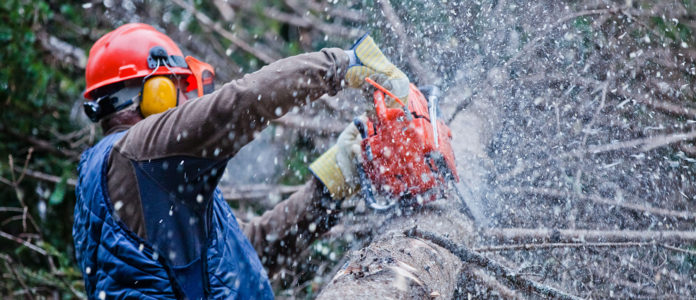Ballpark estimate: $150 to $1,000+
If you live on a rural, wooded lot, you may occasionally have the need for a tree removal service. But tree removal projects are certainly not limited to the country. In fact, you might be surprised to know that many tree removal projects also take place in crowded city locations, as well.
The Need for Tree Removal
Most people cherish their trees, viewing them as lovely additions to their yards and seldom thinking of the need to cut them down. However, trees can become unsightly and sometimes can cause problems that make it essential to remove them for safety’s sake. For example, if a tree is growing too close to your house and foundation, you may need to remove it to save the integrity of the structure. Another challenge occurs when trees begin to die for some reason, due to either disease or damage; they can become dangerous and require removal. Sometimes trees can grow close to utility lines on your property, also causing too much risk.
Why You need an Expert
For whatever reason you decide to remove trees in your yard, the process can range from a very simple one to something that is quite complex. If you often tackle challenging yard work or construction projects, you may be considering removing the ailing tree yourself. Oftentimes, removing a number of relatively small diameter trees from a wooded location far from houses, utility lines, and other structures can be a reasonable task for a talented homeowner with a good chain saw. But removing trees can also pose some serious danger, too. Therefore, most experts agree that if you’ve never tackled tree removal yourself, it’s probably best to hire a qualified contractor to handle the job. Further, certain situations really need to be handled by someone well versed in tree removal who knows what to expect and who has all of the necessary equipment. The types of complicated situations that almost always require professional expertise include trees that are close to the house or power lines, as well as trees that are very large and could put you at risking of causing harm to yourself or your property in the process of cutting the tree or trees down.
Choosing a Tree Removal Contractor
Tree care and removal is a specialized field, which means that when looking for a contractor, it’s important to hire a company that has plenty of experience in this work. In fact, if you have a very special situation (a dead or dying tree or trees wrapped around other trees) consider hiring a certified arborist to assist with the planning and execution of the tree removal process. Dead trees can break unexpectedly and cause a dangerous situation for the workers and anyone in the vicinity. You may also need to hire a lineman from your local power company if the tree is near power lines. Good contractors can guide you in the right direction regarding these choices. One good online source is Angie’s List. In this line of work, having a contractor who is insured is also very important; ask for a certificate from your contractor to ensure he has adequate coverage in the event any damage or injury occurs while he is performing the job. In addition, you should check with your local Better Business Bureau to make sure there aren’t any complaints against the contractor from previous customers.
It’s always a good idea to find a few reputable contractors and call at least two or three of them to get price quotes before proceeding with the job. Just don’t choose on price alone. In fact, you shouldn’t be afraid to pay a little more if you have a good feeling about one contractor over another, since tree removal can be tricky and you want to be comfortable with your choice and not end up paying more later for a job that has gone awry.
Cost for Tree Removal
Tree removal costs include several factors:
- height of the tree;
- diameter of the tree
- condition of the tree;
- location of the tree;
- type of tree;
- removal of branches and trunk.
Some contractors will price based on height and diameter, others will provide a more detailed quote. Often this depends on how many factors are at play. Some more common examples might include: removing a fallen tree, which would be on the low end, costing perhaps between $150 to $250, while removing a small pine or oak tree might start at $200 and go up from there, while removing an average-size tree (40 to 60 feet) in an easily accessible location would be in the $500 range. Larger trees, 80 feet or higher for example, can cost as much as $1,000 to $1,500 to remove.
As mentioned earlier, trees that are growing close to buildings or power lines will require additional costs. One homeowner described a set of three large pine trees that were growing close to the house in the backyard on a crowded lot. This job required a large crane to remove the trees, piece by piece, lifting each section over the house and into the front yard. As you can imagine, costs in an unusual case like this can exceed $1,500 – $2,000.
Just remember that variations in labor cost, terrain, and proximity to buildings, patios, swimming pools, or other man-made structures will often increase the cost so every project is unique.
Other Factors to Consider
Be sure to discuss removal of trunk and branches with the contractor in advance. Most experts will include this with the initial price quote. In fact, because some wood has value for lumber or pulp, it may cost more to keep the wood than have it removed. Should you find yourself in a situation where you are just not sure if you need to have a particular tree removed, or if it can be trimmed back or simply left alone, it’s usually worth having have a tree expert take a look.
If you are hoping to nurse an ailing tree back to good health, it may be worth it to invest in a full tree inspection to assess your tree’s status and determine exactly what it needs. This can be in the $150 range. The contractor may also suggest that a well-planned tree trimming (which can often run about $200 to $400, which may be less than removal and also allows you to retain your tree, so it can be money well spent) will be enough to preserve nearby structures or avoid interference with power lines. This type of preventative care should keep you happy with the aesthetics of your beautiful, shady yard while avoiding problems that might require much more expensive solutions down the line.














































